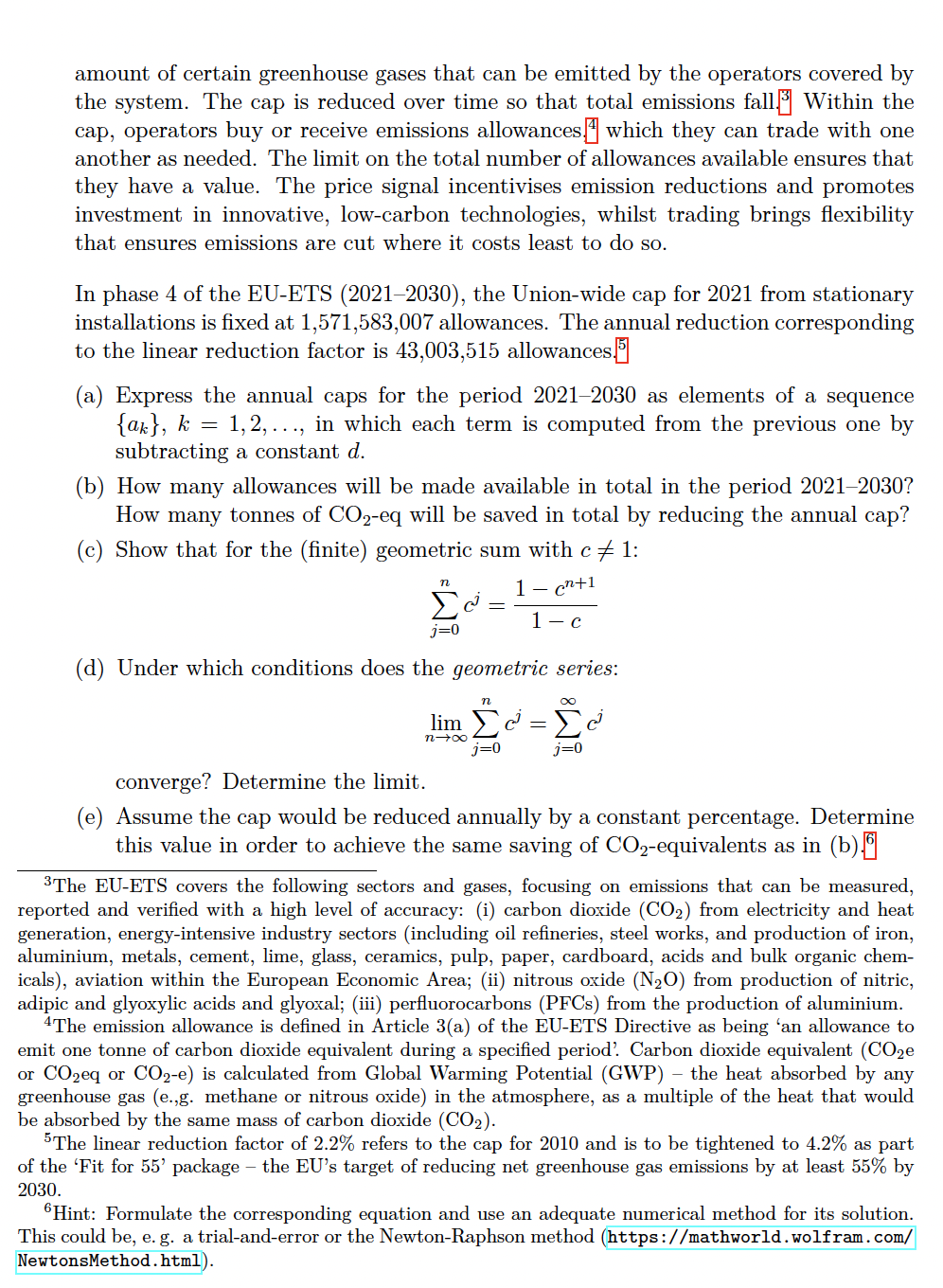Answered step by step
Verified Expert Solution
Question
1 Approved Answer
International carbon markets are an increasingly popular tool to regulate carbon emissions. In 2005, the EU Emissions Trading System (EU-ETS) was introduced to reach


International carbon markets are an increasingly popular tool to regulate carbon emissions. In 2005, the EU Emissions Trading System (EU-ETS) was introduced to reach European climate targets under the Kyoto Protocol. The EU-ETS operates in all EU countries plus Iceland, Liechtenstein and Norway (EEA-EFTA states). The EU-ETS works on the 'cap and trade' principle. A cap is set on the total amount of certain greenhouse gases that can be emitted by the operators covered by the system. The cap is reduced over time so that total emissions fall Within the cap, operators buy or receive emissions allowances which they can trade with one another as needed. The limit on the total number of allowances available ensures that they have a value. The price signal incentivises emission reductions and promotes investment in innovative, low-carbon technologies, whilst trading brings flexibility that ensures emissions are cut where it costs least to do so. In phase 4 of the EU-ETS (2021-2030), the Union-wide cap for 2021 from stationary installations is fixed at 1,571,583,007 allowances. The annual reduction corresponding to the linear reduction factor is 43,003,515 allowances.5 (a) Express the annual caps for the period 2021-2030 as elements of a sequence {ak}, k 1,2,..., in which each term is computed from the previous one by subtracting a constant d. (b) How many allowances will be made available in total in the period 2021-2030? How many tonnes of CO2-eq will be saved in total by reducing the annual cap? (c) Show that for the (finite) geometric sum with c 1: 1-c+1 1-c n @ j=0 (d) Under which conditions does the geometric series: lim n n j=0 [c j=0 converge? Determine the limit. (e) Assume the cap would be reduced annually by a constant percentage. Determine this value in order to achieve the same saving of CO2-equivalents as in (b) The EU-ETS covers the following sectors and gases, focusing on emissions that can be measured, reported and verified with a high level of accuracy: (i) carbon dioxide (CO) from electricity and heat generation, energy-intensive industry sectors (including oil refineries, steel works, and production of iron, aluminium, metals, cement, lime, glass, ceramics, pulp, paper, cardboard, acids and bulk organic chem- icals), aviation within the European Economic Area; (ii) nitrous oxide (NO) from production of nitric, adipic and glyoxylic acids and glyoxal; (iii) perfluorocarbons (PFCs) from the production of aluminium. 4The emission allowance is defined in Article 3(a) of the EU-ETS Directive as being 'an allowance to emit one tonne of carbon dioxide equivalent during a specified period. Carbon dioxide equivalent (COe or COeq or CO2-e) is calculated from Global Warming Potential (GWP) - the heat absorbed by any greenhouse gas (e.,g. methane or nitrous oxide) in the atmosphere, as a multiple of the heat that would be absorbed by the same mass of carbon dioxide (CO). 5The linear reduction factor of 2.2% refers to the cap for 2010 and is to be tightened to 4.2% as part of the 'Fit for 55' package - the EU's target of reducing net greenhouse gas emissions by at least 55% by 2030. 6Hint: Formulate the corresponding equation and use an adequate numerical method for its solution. This could be, e. g. a trial-and-error or the Newton-Raphson method (https://mathworld.wolfram.com/ NewtonsMethod.html).
Step by Step Solution
★★★★★
3.29 Rating (143 Votes )
There are 3 Steps involved in it
Step: 1
a To compute the annual caps for the period 20212030 as elements of a sequence a we start with the initial cap for 2021 and subtract the constant reduction factor each year Let a1 be the cap for 2021 ...
Get Instant Access to Expert-Tailored Solutions
See step-by-step solutions with expert insights and AI powered tools for academic success
Step: 2

Step: 3

Ace Your Homework with AI
Get the answers you need in no time with our AI-driven, step-by-step assistance
Get Started


